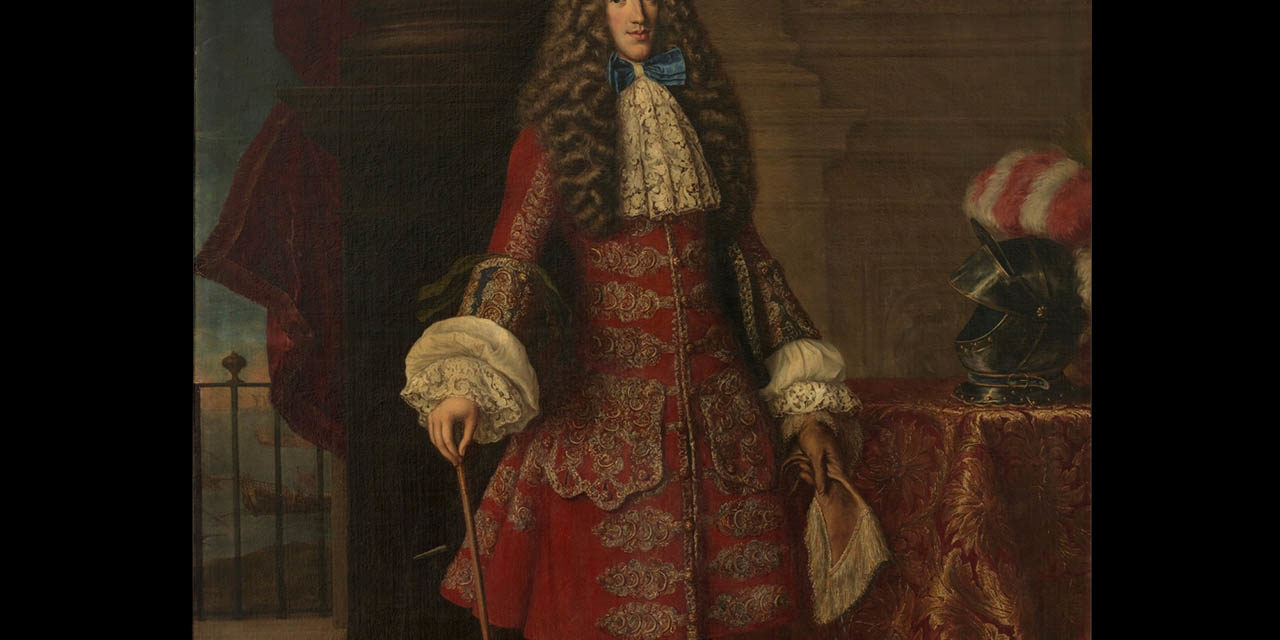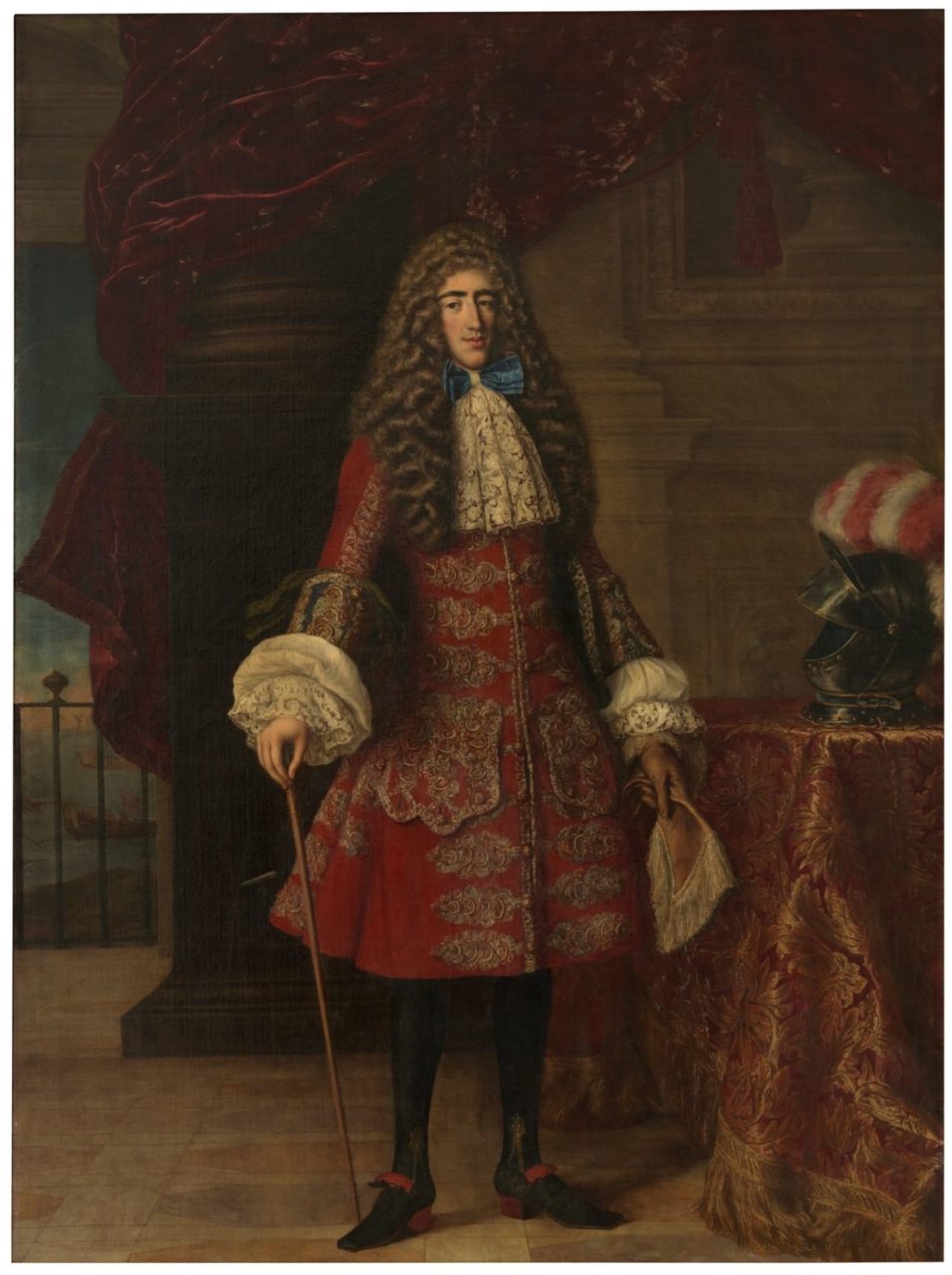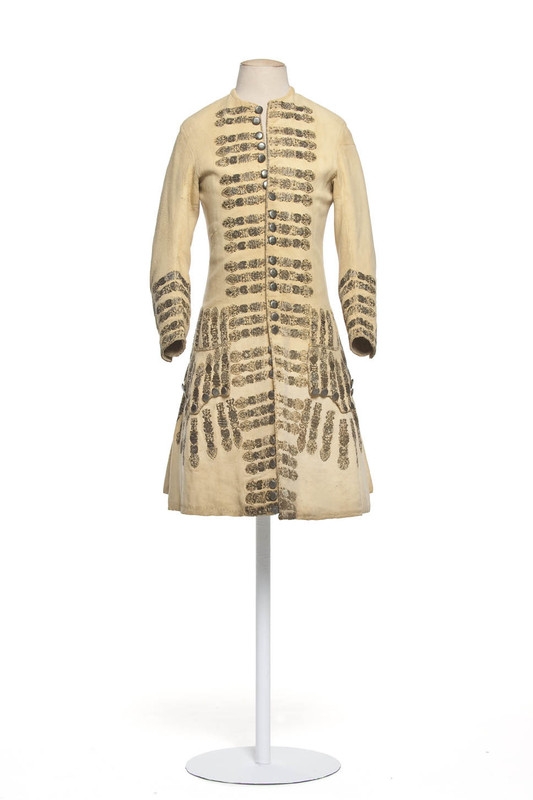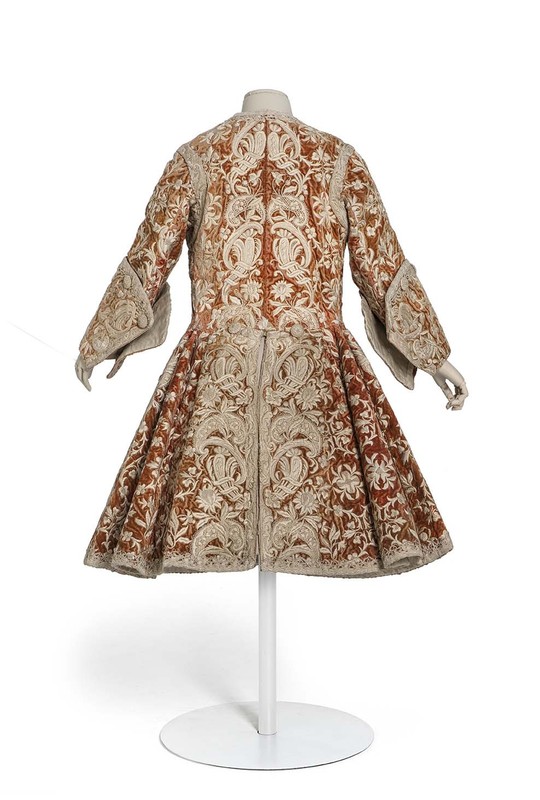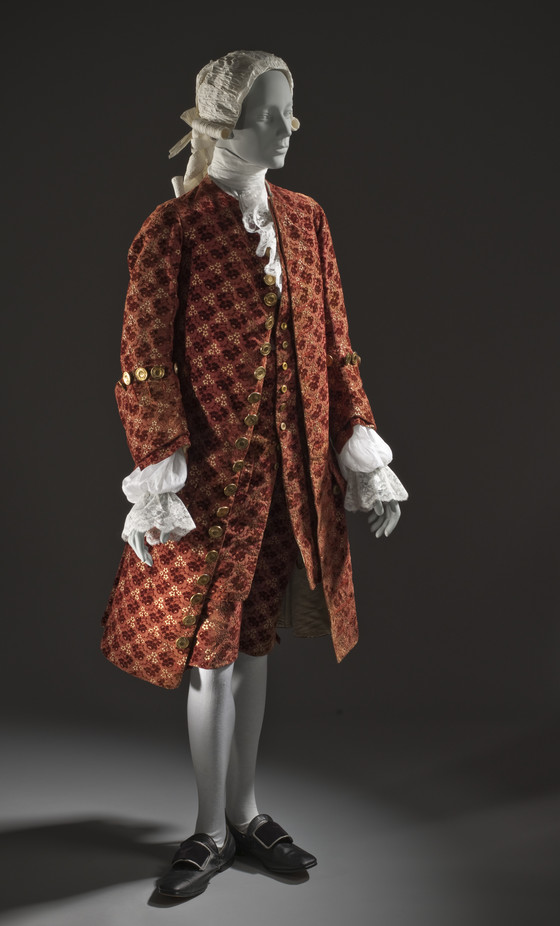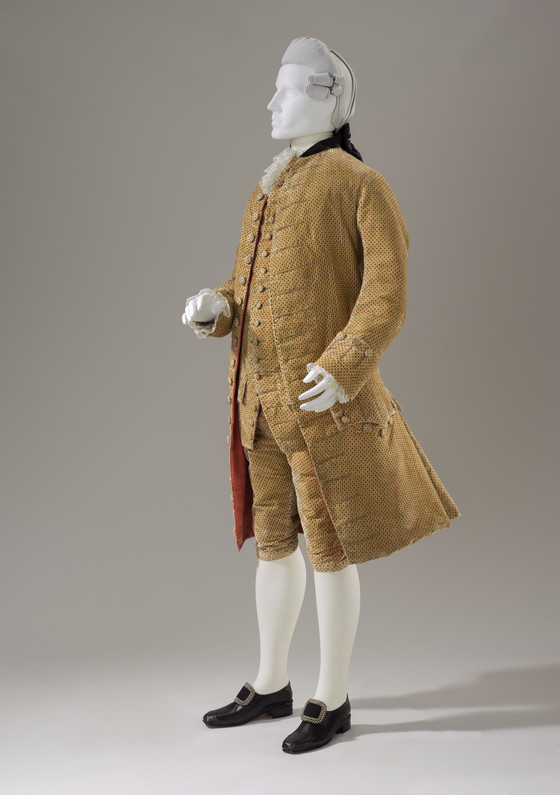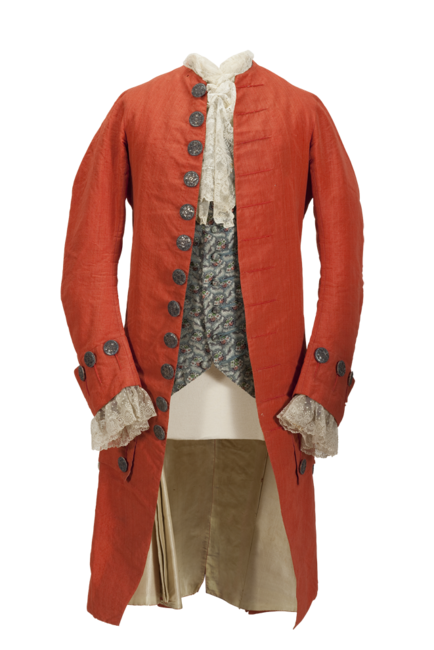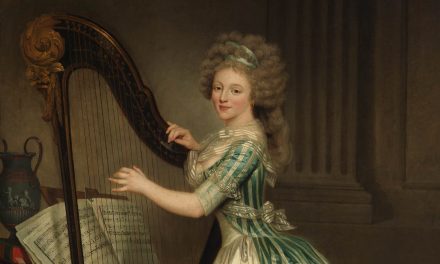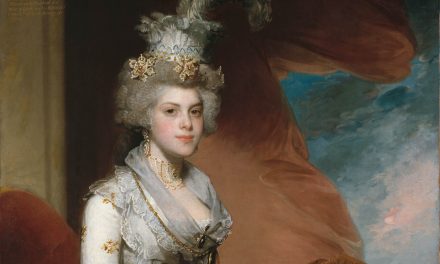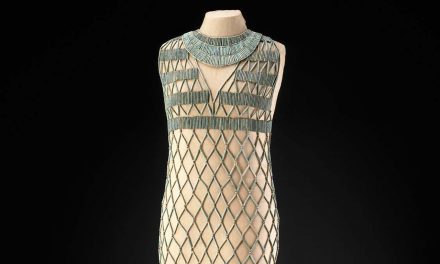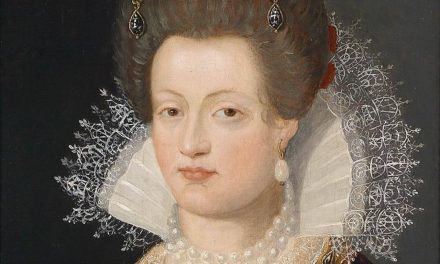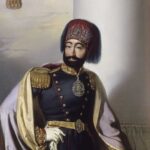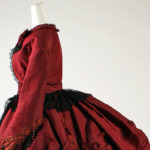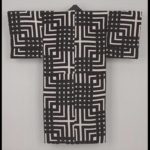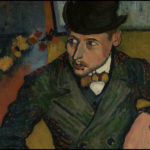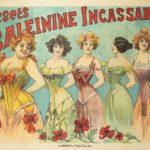A justaucorps is a long-sleeved, knee-length coat worn by men after 1666 and throughout the 18th century.
The Details
For the French garment term justaucorps, fashion historian Phyllis G. Tortora writes in her Survey of Historic Costume (2015):
“Knee length coats that replaced doublets as outer garments. Usually called justaucorps or referred to as surtouts.” (191)
In royal society, justaucorps were generally made out of a luxurious fabric like silk velvet or brocaded and patterned material (Fig. 1). The justaucorps and waistcoat replaced the doublet, a previously popular shorter style of bodiced coat, after 1666 when Charles II proclaimed a new style of dress for the English court. In its first few decades, it was designed to close at center front (Fig. 2), but by the second quarter of the 18th century it was purposefully cut to have a gap at front so that the waistcoat and breeches could be seen.
The justaucorps had a series of buttons and buttonholes along the entire length of the opening, reached to the knees, and had stiff, wide skirting that protruded in back (Fig. 3). The sleeves were fitted, and early versions featured deep cuffs. The whole coat shortened and lost width over the 18th century; cuffs became smaller and the silhouette more streamlined. French justaucorps are generally more ornate (Fig. 4); an English silk suit c. 1765 has a subtler pattern and softer color (Fig. 5), and a simpler red wool justaucorps c. 1780 was inspired by the English style (Fig. 6). It would appear that most contemporary sources simply called these garments “coats”; one of the English terms was ‘frock coat‘.
In Costume, History and Style (1983), Douglas Russell writes:
“A long, fitted coat with full skirt, buttoned down the front with sleeves usually turned back in large cuffs: replaced the cassock about 1675-1680.” (497)
Justaucorps were part of a three-piece habit, or suit, as seen in figures 4 & 5, and a man would not have attended a formal event without one. They had two large pocket flaps and often had embroidered edging, much like the matching waistcoats. While the buttons continued to be present through the end of the 18th century, they were usually just decorative – most justaucorps were not meant to be buttoned closed.
Some justaucorps remained fitted throughout the body, especially the very early and late styles (Figs. 2 & 6), while others featured fashionably accentuated and flared skirts through the addition of gores and pleats from the waist. The front edges are close together at the neck and cut away from the body lower down, sometimes dramatically (Fig. 5).
In A History of Costume (1930) by early dress historian Carl Kohler, justaucorps are described:
“Shortly after the year 1660….This new garment, which was called le justaucorps, and which soon came to be richly decorated with galloon, immediately became a chief item of male costume, and continued – although with repeated modifications – to be worn till about the end of the eighteenth century.” (307-8)
Fig. 1 - Jacob-Ferdinand Voet (Belgian, 1639-1700). Luis Francisco de la Cerda, IX duque de Medinaceli, 1684. Oil on canvas; 231 x 173 cm. Madrid: Museu del Prado, P002561. Legado de Mª. de los Ángeles Medina y Garvey, duquesa de Tarifa, 1934. Source: Museo del Prado
Fig. 2 - Designer unknown (French). Veste, justaucorps, ensemble 2 pièces, 1690. Chamois leather, embroidered gold thread, brandenburg lace, metal buttons.; waist 77 cm, back length 92 cm. Paris: Musée de Arts Decoratifs, LOUVRE OAP 631. Photo by Jean Tholance. Source: MAD
Fig. 3 - Designer unknown (French). Justaucorps, 1715-20. Red velvet, silk embroidery and braid; back length: 76 cm. Paris: Musée de Arts Decoratifs, 19850. Marie Augustine Goy in memory of her husband Charles Piet-Latraudie, 1914. Source: MAD
Fig. 4 - Designer unknown (French). Man's Suit, ca. 1755. Silk cut, uncut, and voided velvet (ciselé) on satin foundation; coat center back length: 101.6 cm (40 in). Los Angeles: Los Angeles County Museum of Art, M.2007.211.947a-c. Purchased with funds provided by Suzanne A. Saperstein and Michael and Ellen Michelson, with additional funding from the Costume Council, the Edgerton Foundation, Gail and Gerald Oppenheimer, Maureen H. Shapiro, Grace Tsao, and Lenore and Richard Wayne. Source: LACMA
Fig. 5 - Designer unknown (English). Three-piece Suit, ca. 1765. Silk cut velvet on plain-weave ground with tie-resist-dyed pile warp (chiné) and self-weft patterning; center back length: 107 cm (42 1/4 in). Los Angeles: Los Angeles County Museum of Art, M.2007.211.798a-c. Purchased with funds provided by Suzanne A. Saperstein and Michael and Ellen Michelson, with additional funding from the Costume Council, the Edgerton Foundation, Gail and Gerald Oppenheimer, Maureen H. Shapiro, Grace Tsao, and Lenore and Richard Wayne. Source: LACMA
Fig. 6 - Designer unknown (English or German). Justaucorps and Waistcoat, ca. 1780. Coat: wool, silk lining; buttons: metal embroidery and sequins; waistcoat: silk droguet, linen, silk lining; l 109 cm. Hamburg: Museum für Kunst und Gewerbe Hamburg. Photo: Roman Raacke. Source: MKG Hamburg
References:
- Kohler, Carl. A History of Costume. Edited by Emma von Sichart. Translated by Alexander K. Dallas. New York: G. Howard Watt, 1930. Archive.org. Accessed 22 November 2019. https://archive.org/details/ost-history-historyofcostume00khle/page/n7
- Russell, Douglas. Costume History and Style. Prentice-Hall, 1983. http://www.worldcat.org/oclc/647522925
- “Seventeenth-Century Clothing.” In European Culture from The Renaissance to the Modern Era, 2nd ed., edited by Sara Pendergast, Tom Pendergast, Drew D. Johnson, and Julie L. Carnagie, 491-509. Vol. 3 of Fashion, Costume, and Culture: Clothing, Headwear, Body Decorations, and Footwear Through the Ages. Detroit, MI: UXL, 2013. Gale eBooks (accessed December 3, 2019). https://libproxy.fitsuny.edu:2653/apps/doc/CX2760000099/GVRL?u=fitsuny&sid=GVRL&xid=4f316a5c.
- Tortora, Phyllis. Survey of Historic Costume. 6th ed. New York, NY: Fairchild Books, 2015. http://www.worldcat.org/oclc/990641691

